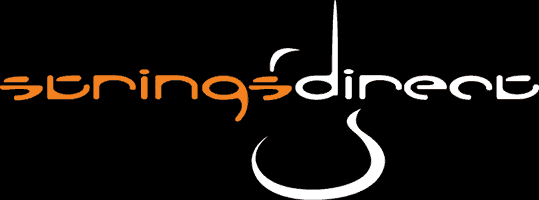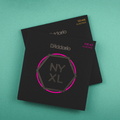Cleaning your guitar's fretboard
By Strings Direct – 29 August, 2023
 Cleaning your guitar’s fretboard isn’t one of the most desirable jobs in the world. Most of us just want to get on with playing and when presented with the choice of cleaning your guitar or playing, it’s pretty obvious which the majority of us would choose. But keeping your fingerboard clean isn’t just for cleanliness sake, it does have a practical benefit too.
So what are some basic rules for keeping your fretboard in good nick? Well first it’s best to note that rosewood, ebony or dark wood fingerboards should be treated slightly different to maple fingerboards. More of that later but there are a few other tips we can all do to help our cause.
If you look after your guitar’s fingerboard, it will look after your playing too. Believe it or not a dirty fingerboard can hamper your technique and in turn your tone. All the sweat, dirt and oils released through those hours of playing are transferred to your strings. In turn these make their way onto the fingerboard creating a build-up of nasty crud. If left this becomes sticky over time so sliding around the neck and strings isn’t as easy or pleasant as it should be! In some extreme cases it can eventually rot a fingerboard and get in between the frets and fretboard joints – not good! If it's not removed sooner rather than later it can cause a whole host of headaches over time.
Cleaning your guitar’s fretboard isn’t one of the most desirable jobs in the world. Most of us just want to get on with playing and when presented with the choice of cleaning your guitar or playing, it’s pretty obvious which the majority of us would choose. But keeping your fingerboard clean isn’t just for cleanliness sake, it does have a practical benefit too.
So what are some basic rules for keeping your fretboard in good nick? Well first it’s best to note that rosewood, ebony or dark wood fingerboards should be treated slightly different to maple fingerboards. More of that later but there are a few other tips we can all do to help our cause.
If you look after your guitar’s fingerboard, it will look after your playing too. Believe it or not a dirty fingerboard can hamper your technique and in turn your tone. All the sweat, dirt and oils released through those hours of playing are transferred to your strings. In turn these make their way onto the fingerboard creating a build-up of nasty crud. If left this becomes sticky over time so sliding around the neck and strings isn’t as easy or pleasant as it should be! In some extreme cases it can eventually rot a fingerboard and get in between the frets and fretboard joints – not good! If it's not removed sooner rather than later it can cause a whole host of headaches over time.
 A soft, clean, dry rag ran over the strings after you’ve finished playing will usually suffice. Cotton T-Shirts or cotton cloths (as pictured to the left) are usually the best for these jobs.
If you really wanted to go a step further you can use a dedicated string cleaner. Something like Planet Waves XLR8 String Lubricant Cleaner or GHS Fast Fret would be a good choice. Another neat little bit of kit is The Swipe. After you’ve wiped your clean rag over the tops of your strings, run this under the strings and this will get rid of any nasties that have made their way to the underside of the strings.
If you really wanted to go one step further, you could slacken off your strings. This will give you enough room underneath the strings to access the fingerboard and give this a good once over with your cloth too.
If you can make a habit of cleaning your strings after playing, not only will your fretboard be grateful, your strings will retain their life and brightness for a lot longer too. Win-Win!!
A soft, clean, dry rag ran over the strings after you’ve finished playing will usually suffice. Cotton T-Shirts or cotton cloths (as pictured to the left) are usually the best for these jobs.
If you really wanted to go a step further you can use a dedicated string cleaner. Something like Planet Waves XLR8 String Lubricant Cleaner or GHS Fast Fret would be a good choice. Another neat little bit of kit is The Swipe. After you’ve wiped your clean rag over the tops of your strings, run this under the strings and this will get rid of any nasties that have made their way to the underside of the strings.
If you really wanted to go one step further, you could slacken off your strings. This will give you enough room underneath the strings to access the fingerboard and give this a good once over with your cloth too.
If you can make a habit of cleaning your strings after playing, not only will your fretboard be grateful, your strings will retain their life and brightness for a lot longer too. Win-Win!!
Rosewood / Ebony and Dark Fingerboards
If your rosewood or ebony fingerboard isn’t in too much need of a complete overhaul, a clean damp (definitely not sopping!) cloth and a healthy dose of elbow grease may be enough to dislodge the grime that’s sitting on your fingerboard. However, if you find yourself with a particularly grimey fingerboard you may want to take some extra measures in cleaning some of that muck off. If the dirt has become hard and stubborn to remove you may have to use a dedicated cleaner to help penetrate the dirt sitting there. We have found the Jim Dunlop Fretboard Cleaner to be a good choice. The Ernie Ball Wonder Wipes are also a nice product. They come in neat little sachets and are great for a quick single use... just don't clean your fingers with them after your KFC! It's always best to apply any spray cleaning fluid to a clean cloth first and then to your fingerboard. Directly spraying onto the fingerboard isn’t a huge issue, but just avoids you applying too much. Now it’s time to get to work and get rid of all that build-up of crap that’s been sitting there for god knows how long... Rub the board to clean it using a soft, clean rag (again a cotton cloth or cotton T-shirt will do just fine). You’ll often find that a lot of the dirt will tend to accumulate around the edges of the frets and fretjoint (join where the fret meets the fretboard). Something like a toothpick or a cotton wool bud is ideal for accessing this tight little spot and getting rid of those final bits of dirt (NOT a flathead screwdriver - you know who you are!). Rosewood and Ebony boards aren’t treated or sealed with any lacquer so will occasionally need an application of oil to ensure that they stay hydrated. Applying a small amount of lemon oil to a soft dry rag and in turn to the board will ensure it shouldn’t dry out. It’s not essential to do this every time you clean your board, just when it looks a bit dry and has lost it’s dark rich colour. An excessively dry fingerboard can crack and also lead to shrinkage. You’ll know if your board has shrunk as when you run your hand up and down the neck you can feel the frets hanging over the edge and they feel sharp against your hand. The central heating in our houses can certainly play a big part in drying out the wood in our guitars.Now’s the time to buff up those frets!...
To bring the shine back to your frets, many people will use soft wire wool. The 0000 grade stuff is the only steel wool to use here as anything else is just too abrasive! Some luthiers will actually use the 0000 wire wool to clean a rosewood fingerboard too. This grade of wool is actually quite gentle and won’t damage the fretboard if used sensibly. However, if you are using this to simply bring that zing back to your frets, we’d always recommend using a low tack (less sticky) masking tape on your fretboard to avoid making any unnecessary marks in the fretboard. Planet Waves make their own fret polishing cloth which I personally use (see right). In the package they also provide a neat little template that you can use to effectively frame your fret and prevent you from rubbing your fretboard too. Definitely a good time-saver over using using masking tape.
If you can’t be faffed with all this malarkey, you may be interested in a product called Gorgomyte. This Fret and Fingerboard cleaning and conditioning cloth can be used to clean your frets and your fingerboard. It was developed by USA luthier Jimmy Johns. It makes the job so quick and because it’s dual purpose (cleans both fretboard and frets) there’s no need to mask off your board when you want to clean your frets. Not to mention, it can be used on maple fingerboards too…
Planet Waves make their own fret polishing cloth which I personally use (see right). In the package they also provide a neat little template that you can use to effectively frame your fret and prevent you from rubbing your fretboard too. Definitely a good time-saver over using using masking tape.
If you can’t be faffed with all this malarkey, you may be interested in a product called Gorgomyte. This Fret and Fingerboard cleaning and conditioning cloth can be used to clean your frets and your fingerboard. It was developed by USA luthier Jimmy Johns. It makes the job so quick and because it’s dual purpose (cleans both fretboard and frets) there’s no need to mask off your board when you want to clean your frets. Not to mention, it can be used on maple fingerboards too…
Maple Fingerboards
There seems to be a lot of products out on the market tailored to looking after fingerboards made of rosewood or ebony but hardly anything for maple so we’re often asked by our customers how they should clean their maple fingerboard. Maple fingerboards are typically lacquered and this acts as a seal so essentially we just need to be concerned with doing away with all that dirt. They shouldn’t be scraped or rubbed with 0000 wire wool as this can remove the gloss finish. Lemon Oil is not recommended to be applied to maple fingerboards either. Depending on the amount of dirt built up on your maple fingerboard, you may only need a lightly damp (not sopping) clean rag and elbow grease to dislodge the dirt. If the dirt is a little bit more stubborn (or the old tennis elbow starts to give you some jip) you can dip a soft dry rag in something a little stronger. Famous US repair man Dan Erlewine recommends lighter fluid (naptha). It’s a great degreaser for your fingerboard but use sparingly and be very careful of this making contact with your skin or eyes. Don't do what Jimi did... he went a bit bananas when cleaning his fretboard... Another alternative would be servisol foam cleaner. Apply a small amount to the fingerboard to let it loosen the dirt, then simply wipe it away. Simples!
Polish also is used to clean maple fingerboards. If you do use a polish be sure to avoid anything that contains silicone as it really isn’t best friends with lacquered finishes.
Once you’ve given your board a good clean you can move on to the frets (as directed above). When you polish the frets up, if you are using 0000 wire wool it’s always a good idea to ensure the wool doesn’t make contact with your maple fingerboard. As mentioned previously, the wool can remove the gloss finish. To avoid this, it’s best to use a template (like in the Planet Waves Fret Polishing System) or mask off the frets using a low-tack masking tape. Ensure it’s low tack you use as anything with a bit more tack can damage the lacquer when being removed.
Once again, if all this sounds like a bit too much work, the Gorgomyte Cleaning cloth is always a great option. It’s non-abrasive and can be used to clean your maple fingerboard and frets making it a super quick job!
Another alternative would be servisol foam cleaner. Apply a small amount to the fingerboard to let it loosen the dirt, then simply wipe it away. Simples!
Polish also is used to clean maple fingerboards. If you do use a polish be sure to avoid anything that contains silicone as it really isn’t best friends with lacquered finishes.
Once you’ve given your board a good clean you can move on to the frets (as directed above). When you polish the frets up, if you are using 0000 wire wool it’s always a good idea to ensure the wool doesn’t make contact with your maple fingerboard. As mentioned previously, the wool can remove the gloss finish. To avoid this, it’s best to use a template (like in the Planet Waves Fret Polishing System) or mask off the frets using a low-tack masking tape. Ensure it’s low tack you use as anything with a bit more tack can damage the lacquer when being removed.
Once again, if all this sounds like a bit too much work, the Gorgomyte Cleaning cloth is always a great option. It’s non-abrasive and can be used to clean your maple fingerboard and frets making it a super quick job!
 We hope that this has given you some insight into looking after your fretboard a bit more. It might seem a bit of a boring job but something that shouldn't be overlooked when looking after your guitar.
As always if you’re ever unsure of how to clean your guitar or want any advice, just drop us a line and we’d always be happy to help where we can.
We hope that this has given you some insight into looking after your fretboard a bit more. It might seem a bit of a boring job but something that shouldn't be overlooked when looking after your guitar.
As always if you’re ever unsure of how to clean your guitar or want any advice, just drop us a line and we’d always be happy to help where we can.





